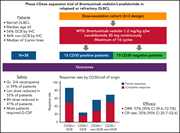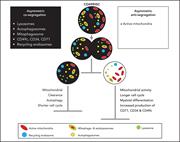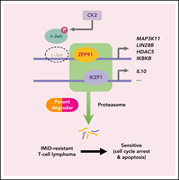Issue Archive
Table of Contents
BLOOD COMMENTARIES
PLENARY PAPER
Systems medicine dissection of chr1q-amp reveals a novel PBX1-FOXM1 axis for targeted therapy in multiple myeloma
Amplification of chromosome 1q (chr1q-amp) is an adverse prognostic feature in multiple myeloma (MM). In this Plenary paper, Trasanidis and colleagues perform elegant studies integrating multi-omics datasets with genetic variables to elucidate the genes and pathways governing the negative prognosis conferred by chr1q-amp, identifying that the transcription factor PBX1 directs a FOXM1-dependent oncogenic program that activates proliferation. Inhibition of PBX-FOXM1 is selectively toxic to chr1q-amp cells, suggesting a novel targeted strategy for this adverse subtype of MM.
REVIEW SERIES
Complement and the prothrombotic state
This review series on immunohemostasis highlights the crosstalk between immunity and hemostasis. In the first article, Schmidt, Schrezenmeier, and Kavanagh discuss the role of activation of the terminal pathway of complement in thrombosis associated with paroxysmal nocturnal hemoglobinuria, atypical hemolytic-uremic syndrome, autoimmune hemolytic anemia, and other complement activating syndromes. In the second, Popescu, Lupu, and Lupu discuss the role of immune response in the initiation of disseminated intravascular coagulation through responses to pathogen-associated or host-derived damage-associated molecular pattern, and its perpetuation through other immune and inflammatory pathways. In the final article of the series, Kizhakkedathu and Conway discuss the role of immunoinflammatory pathways in the response of exposure of blood to foreign surfaces in biomaterial devices or implanted tissues.
Disseminated intravascular coagulation and its immune mechanisms
This review series on immunohemostasis highlights the crosstalk between immunity and hemostasis. In the first article, Schmidt, Schrezenmeier, and Kavanagh discuss the role of activation of the terminal pathway of complement in thrombosis associated with paroxysmal nocturnal hemoglobinuria, atypical hemolytic-uremic syndrome, autoimmune hemolytic anemia, and other complement activating syndromes. In the second, Popescu, Lupu, and Lupu discuss the role of immune response in the initiation of disseminated intravascular coagulation through responses to pathogen-associated or host-derived damage-associated molecular pattern, and its perpetuation through other immune and inflammatory pathways. In the final article of the series, Kizhakkedathu and Conway discuss the role of immunoinflammatory pathways in the response of exposure of blood to foreign surfaces in biomaterial devices or implanted tissues.
Biomaterial and cellular implants: foreign surfaces where immunity and coagulation meet
This review series on immunohemostasis highlights the crosstalk between immunity and hemostasis. In the first article, Schmidt, Schrezenmeier, and Kavanagh discuss the role of activation of the terminal pathway of complement in thrombosis associated with paroxysmal nocturnal hemoglobinuria, atypical hemolytic-uremic syndrome, autoimmune hemolytic anemia, and other complement activating syndromes. In the second, Popescu, Lupu, and Lupu discuss the role of immune response in the initiation of disseminated intravascular coagulation through responses to pathogen-associated or host-derived damage-associated molecular pattern, and its perpetuation through other immune and inflammatory pathways. In the final article of the series, Kizhakkedathu and Conway discuss the role of immunoinflammatory pathways in the response of exposure of blood to foreign surfaces in biomaterial devices or implanted tissues.
CLINICAL TRIALS AND OBSERVATIONS
Phase 1/dose expansion trial of brentuximab vedotin and lenalidomide in relapsed or refractory diffuse large B-cell lymphoma
Clinical Trials & Observations
The potential approaches to patients with relapsed/refractory (R/R) diffuse large B-cell lymphoma (DLBCL) continue to expand. Ward et al report on a Phase 1 study of 37 patients with R/R DLBCL ineligible for autologous transplant treated with brentuximab vedotin and lenalidomide. Therapy was well-tolerated and yielded an overall response rate of 57% with a complete response rate of 35%. This promising potential treatment option is currently being explored in a Phase 3 trial.
Always be prepared for success
Clinical Trials & Observations
HEMATOPOIESIS AND STEM CELLS
Asymmetric organelle inheritance predicts human blood stem cell fate
How asymmetric cell division regulates stem cell fate is an ongoing mystery. Loeffler et al use elegant single-cell imaging to document that lysosomes and mitochondria are asymmetrically inherited along with other organelles and that this asymmetric inheritance governs stem cell and surface marker expression, contributing to divergent stem cell fate.
LYMPHOID NEOPLASIA
Overcoming IMiD resistance in T-cell lymphomas through potent degradation of ZFP91 and IKZF1
MYELOID NEOPLASIA
Coordinated missplicing of TMEM14C and ABCB7 causes ring sideroblast formation in SF3B1-mutant myelodysplastic syndrome
SF3B1 mutations are characteristic of myelodysplastic syndromes with ring sideroblasts, but the mechanism of dysregulated iron metabolism has been unclear. Clough et al use induced pluripotent stem cells derived from a patient with mutant SF3B1 to identify TMEM14C and ABCB7, two mitochondrial membrane transporters, as the principle mis-spliced proteins responsible for iron sequestration and ring sideroblast formation.
PLATELETS AND THROMBOPOIESIS
TRANSPLANTATION
Hematopoietic stem cell transplantation for Wiskott-Aldrich syndrome: an EBMT Inborn Errors Working Party analysis
Clinical Trials & Observations
Albert and colleagues report on hematopoietic stem cell transplant (HSCT) outcomes in 197 patients transplanted between 2006 and 2017 with uniform conditioning using 1 of 2 recommended regimens. Outcomes are excellent, with an overall 3-year survival of 88.7% and a chronic graft-versus-host disease-free survival of 81.7%. The only feature associated with adverse outcomes is age > 5 years at HSCT.
LETTER TO BLOOD
Mortality in β-thalassemia patients with confirmed pulmonary arterial hypertension on right heart catheterization
Clinical Trials & Observations
Pulmonary arterial hypertension (PAH) is a life-threatening complication of β-thalassemia, especially in untransfused patients with thalassemia intermedia. Pinto and colleagues analyzed the outcome of 24 patients with PAH documented by right heart catheterization, and they report that with a median follow-up of 4 years, 54% died, most of which deaths were attributable to PAH. Patients who receive treatment that reduce their pulmonary pressures have improved survival, suggesting that improvement in monitoring and treatment are critical imperatives for these patients.
BLOOD WORK
ERRATA
-
Cover Image
Cover Image
![issue cover]()
Ring sideroblasts visualized by Prussian blue iron staining (blue) differentiated from SF3B1-mutant induced pluripotent stem cells. These data show how aberrant gene splicing causes ring sideroblast formation. See the article by Clough et al on page 2038.
- PDF Icon Front MatterFront Matter
- PDF Icon Table of ContentsTable of Contents
- PDF Icon Editorial BoardEditorial Board
Advertisement intended for health care professionals
Email alerts
Advertisement intended for health care professionals













Agent myeloma has a new weapon from (ch1)Q